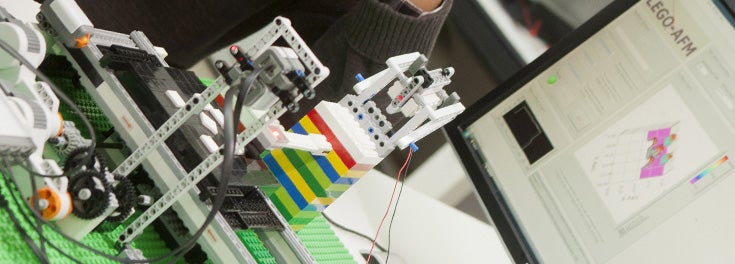
At URI, you don’t have to wait until you’re a graduate student, or even a senior, to do meaningful work. Just ask Ron Sadlier ’15. As a sophomore physics and applied math major, he created a Lego-based atomic force microscope that’s going to help teach middle- and high-school students about the growing field of nanotechnology.
Nanotechnology – the manipulation of matter on the teeny-tiniest of scales -is a science and engineering field growing by leaps and bounds with applications in medicine, electronics and energy. But it’s not taught in K-12 because of the absence of age-appropriate teaching materials. An atomic force microscope allows scientists to see, measure, and modify material that’s too small even for the kind of optical microscope most of us have used in science classes.
“Middle and high school students know about molecules, which are smaller than a nanometer, and they learn about very small stuff in chemistry, physics and biology. But they’re not exposed to nanotechnology education,” said Assistant Professor of Mechanical Engineering Keunhan Park. Ron’s project aims to take nanotechnology education to younger students in a form they’ll understand and appreciate. And what could be better than Lego’s?
Under Park’s guidance, and with funding from the National Science Foundation, Ron has managed to use Lego bricks, a Lego-Mindstorm controller, a low-power laser, and software to create an atomic force microscope device that mimics a real atomic force microscope, allowing people to create a 3-D graph of scanned Lego brick.
It was a learning experience for him, too. “I didn’t know anything about atomic force microscopes before I started this project, but it really helped me understand nanotechnology. And if it helped me, it can help other students, too,” Ron said.
Most students are unfamiliar with atomic force microscopes because they are expensive and often too small to see and understand how they operate. Park says Ron’s Lego device is a good starting point for introducing young students how to see objects that are so small he calls them “nano-things.”
Park and Ron plan to invite interested high school students to URI next spring and summer for workshops on nanotechnology during which the participants will build the Lego microscope and then observe how a real atomic force microscope operates. “We want the younger generation to be prepared for this technology that will become a driving technology of our future for sure,” Park said.
Ron isn’t too worried. “I’m pretty sure that once students start playing with it, they’ll realize how cool nanotechnology really is. It will definitely get them interested in science and math.”
Related Links:
Sadlier and Park have prepared a parts list, guidelines and downloadable software so that anyone interested in building their own Lego atomic force microscopes will be able to do so.
